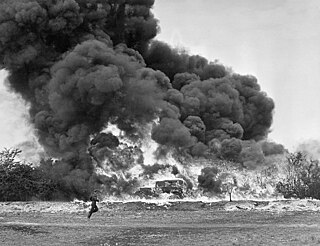
Antimony is a chemical element with symbol Sb (from Latin: stibium) and atomic number 51. A lustrous gray metalloid, it is found in nature mainly as the sulfide mineral stibnite (Sb2S3). Antimony compounds have been known since ancient times and were powdered for use as medicine and cosmetics, often known by the Arabic name, kohl. Metallic antimony was also known, but it was erroneously identified as lead upon its discovery. The earliest known description of the metal in the West was written in 1540 by Vannoccio Biringuccio.

Barium is a chemical element with symbol Ba and atomic number 56. It is the fifth element in group 2 and is a soft, silvery alkaline earth metal. Because of its high chemical reactivity, barium is never found in nature as a free element. Its hydroxide, known in pre-modern times as baryta, does not occur as a mineral, but can be prepared by heating barium carbonate.

Fireworks are a class of low explosive pyrotechnic devices used for aesthetic and entertainment purposes. The most common use of a firework is as part of a fireworks display, a display of the effects produced by firework devices. Fireworks competitions are also regularly held at a number of places.

A flamethrower is a mechanical incendiary device designed to project a long, controllable stream of fire. They were first used by the Greeks in the 1st century AD. In modern times, they were used during World War I, and more widely in World War II.
A projector is a device that projects an image on a surface.

Barium nitrate is the inorganic compound with the chemical formula Ba(NO3)2. It, like most barium salts, is colorless, toxic, and water-soluble. It burns with a green flame and is an oxidizer; the compound is commonly used in pyrotechnics.
A pyrotechnic colorant is a chemical compound which causes a flame to burn with a particular color. These are used to create the colors in pyrotechnic compositions like fireworks and colored fires. The color-producing species are usually created from other chemicals during the reaction. Metal salts are commonly used; elemental metals are used rarely.

The Livens Projector was a simple mortar-like weapon that could throw large drums filled with flammable or toxic chemicals.

A punk is a smoldering stick used for lighting firework fuses. It is safer than a match or a lighter because it can be used from a greater distance and does not use an open flame. They are made of bamboo and a brown coating of compressed sawdust. Punks often resemble sticks of incense, and in some countries actual incense sticks are used in a similar fashion. Punks are sold at nearly all firework stands and many stands will include them for free with a purchase.

Strontium nitrate is an inorganic compound made of the elements strontium and nitrogen with the formula Sr(NO3)2. This colorless solid is used as a red colorant and oxidizer in pyrotechnics.
Zara, Priestess of the Crimson Flame is a villain who battled the Golden Age Wonder Woman. She was also a member of the super-villain team Villainy Inc. She debuted in Comic Cavalcade #5 and was created by Dr. William Moulton Marston as an example of the follies of misandry and another embodiment of emotionally misaligned women whom Wonder Woman must reform.

Copper benzoate is the chemical compound with the formula Cu(C6H5CO2)2. This coordination complex is derived from the cupric ion and the conjugate base of benzoic acid. Because copper emits blue in a flame, this salt has found some use as a source of blue light in fireworks.

A beam projector is a lenseless stage lighting instrument with very little beam spread. It uses two reflectors. The primary reflector is a parabolic reflector and the secondary reflector is a spherical reflector. The parabolic reflector organizes the light into nearly parallel beams, and the spherical reflector is placed in front of the lamp to reflect light from the lamp back to the parabolic reflector, which reduces spill. The result is an intense shaft of light that cannot be easily controlled or modified. Beam projectors are often used to create a godspot effect. The beam projector no longer is used to the extent that it once was, as newer fixtures and PAR lamps have created easier ways to produce the effect. A similar effect can be produced using ETC Source Four PAR fixtures with a clear lens. A snoot/top hat can be added to control spill.

The ROKS-2 and ROKS-3 were man-portable flamethrowers used by the USSR in the Second World War.

A flame fougasse is a type of mine or improvised explosive device which uses an explosive charge to project burning liquid onto a target. The flame fougasse was developed by the Petroleum Warfare Department in Britain as an anti-tank weapon during the invasion crisis of 1940. During that period, about 50,000 flame fougasse barrels were deployed in some 7,000 batteries, mostly in southern England and a little later at 2,000 sites in Scotland. Although never used in combat in Britain, the design saw action later in Greece.

A spark is an incandescent particle. Sparks may be produced by pyrotechnics, by metalworking or as a by-product of fires, especially when burning wood.

Livens Large Gallery Flame Projectors were large experimental flamethrowers used by the British Army in World War I, named after their inventor, Royal Engineers officer William Howard Livens.

Multi-image is the now largely obsolete practice and business of using 35mm slides (diapositives) projected by single or multiple slide projectors onto one or more screens in synchronization with an audio voice-over or music track. Multi-image productions are also known as multi-image slide presentations, slide shows and diaporamas and are a specific form of multimedia or audio-visual production.

















